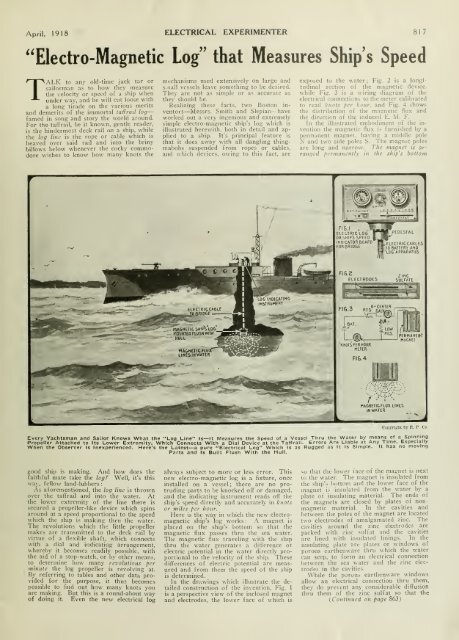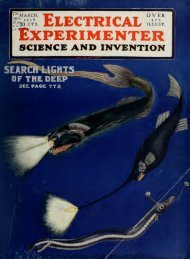The Electrical experimenter
The Electrical experimenter
The Electrical experimenter
Create successful ePaper yourself
Turn your PDF publications into a flip-book with our unique Google optimized e-Paper software.
April, 1918 ELECTRICAL EXPERIMENTER 817<br />
"Electro-Magnetic Log" that Measures Ships Speed<br />
TALK<br />
to any old-time jack tar or<br />
sailorman as to how they measure<br />
the velocitj or speed of a ship when<br />
under way, and he will cut loose with<br />
a long tirade on the various merits<br />
and demerits of the immortal taffrail log—<br />
famed in song and story the world around.<br />
For the taffrail, be it known, gentle reader,<br />
is the hindermost deck rail on a ship, while<br />
the log line is the rope or cable which is<br />
heaved over said rail and into the briny<br />
billows below whenever the cocky commodore<br />
wishes to know how many knots the<br />
mechanisms used extensively on large and<br />
s.nall vessels leave something to be desired.<br />
<strong>The</strong>y are not as simple or as accurate as<br />
they should be.<br />
Realizing these facts, two Boston inventors—Messrs.<br />
Smith and Slepian—have<br />
worked out a very ingenious and extremely<br />
simple electro-magnetic ship's log which is<br />
illustrated herewith, both in detail and applied<br />
to a ship. It's principal feature is<br />
that it does away with all dangling thingmabobs<br />
suspended from ropes or cables,<br />
and which devices, owing to this fact, are<br />
exposed to the water : Fig. 2 is a longitudinal<br />
section of the magnetic device,<br />
while Fig. 3 is a wiring diagram of the<br />
electrical connections to the meter calibrated<br />
to read knots per hour, and Fig. 4 shows<br />
the distribution of the magnetic flux and<br />
the direction of the induced E. M. F.<br />
In the illustrated embodiment of the invention<br />
the magnetic flux is furnished by a<br />
permanent magnet, having a middle pole<br />
N and two side poles S. <strong>The</strong> magnet poles<br />
are long and narrow. <strong>The</strong> magnet is arranged<br />
permanently in the ship's bottom<br />
FIG.I<br />
ELECTRIC LOC,<br />
OR SHIP'S SPEEO<br />
INDICATOR BOARD<br />
F0RBRID6E<br />
FIG.2<br />
ELECTRODES<br />
FI&.3<br />
KNOTS PER HOUR<br />
MITER<br />
FI&.4<br />
ELECTRICCABLES<br />
TO BATTERY AMD<br />
XO&'APPARATUS<br />
MAGNETIC FLUX LIMES<br />
IN WATER<br />
Copyright by E. P. Co.<br />
Every Yachtsman and Sailor Knows What the "Log Line" Is— It Measures the Speed of a Vessel Thru the Water by means of a Spinning<br />
Propeller Attached to Its Lower Extremity, Which Connects With a Dial Device at the Taffrail. Errors Are Liable at Any Time, Especially<br />
When the Observer Is Inexperienced. Here's the Latest—a pure "<strong>Electrical</strong> Log" Which Is as Rugged as It Is Simple. It has no moving<br />
Parts and Is Built Flush With the Hull.<br />
good ship is making. And how does the<br />
faithful mate take the log? Well, it's this<br />
way. fellow land-lubbers<br />
As aforementioned, the log line is thrown<br />
over the taffrail and into the water. At<br />
the lower extremity of the line there is<br />
secured a propeller-like device which spins<br />
around at a speed proportional to the speed<br />
which the ship is making thru the water.<br />
<strong>The</strong> revolutions which the little propeller<br />
makes are transmitted to the deck rail by<br />
virtue of a flexible shaft, which connects<br />
with a dial and indicating arrangement,<br />
whereby it becomes readily possible, with<br />
the aid of a stop-watch, or by other means,<br />
to determine how many revolutions per<br />
minute the log<br />
By referring to<br />
propeller is revolving at.<br />
tables and other data provided<br />
for the purpose, it thus becomes<br />
possible to find out how many knots you<br />
are making. But this is a round-about way<br />
of doing it. Even the new electrical log<br />
:<br />
always subject to more or less error. This<br />
new electro-magnetic log is a fixture, once<br />
installed on a vessel ; there are no protruding<br />
parts to be knocked off or damaged,<br />
and the indicating instrument reads off the<br />
ship's speed directly and accurately in knots<br />
or miles per hour.<br />
Here is the way in which the new electro-<br />
A magnet is<br />
magnetic ship's log works :<br />
placed on the ship's bottom so that the<br />
magnetic flux passes thru the sea water.<br />
<strong>The</strong> magnetic flux traveling with the ship<br />
thru the water generates a difference ot<br />
electric potential in the water directly proportional<br />
to the velocity of the ship. <strong>The</strong>se<br />
differences of electric potential are measured<br />
and from them the speed of the ship<br />
is determined.<br />
In the drawings which illustrate the detailed<br />
construction of the invention. Fig. 1<br />
is a perspective view of the inclosed magnet<br />
and electrodes, the lower face of which is<br />
so that the lower face of the magnet is next<br />
to the water. <strong>The</strong> magnet is insulated from<br />
the ship's bottom and the lower face of the<br />
magnet is insulated from the water by a<br />
plate of insulating material. <strong>The</strong> ends of<br />
the magnets are closed by plates of nonmagnetic<br />
material. In the cavities and<br />
between the poles of the magnet are located<br />
two electrodes of amalgamated zinc. <strong>The</strong><br />
cavities around the zinc electrodes are<br />
packed with zinc sulfat and the cavities<br />
are lined with insulated linings. In the<br />
insulating plate are plates or windows of<br />
porous earthenware thru which the water<br />
can seep, to form an electrical connection<br />
between the sea water and the zinc electrodes<br />
in the cavities.<br />
While the porous earthenware windows<br />
allow an electrical connection thru them,<br />
they do prevent any considerable diffusion<br />
thru them of the zinc sulfat so that the<br />
(Continued on page 863)




